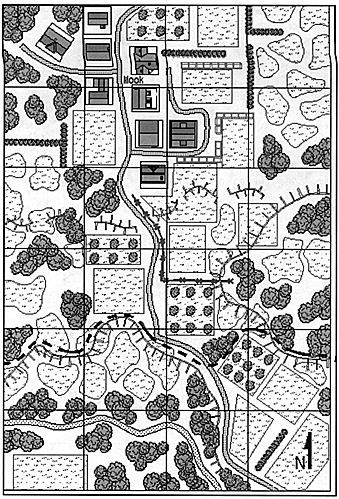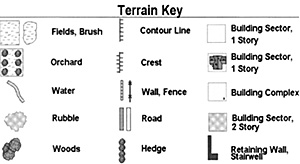Historical Situation:
At 1400 on 17 September, BG Gavin's 82nd Airborne Division dropped successfully between Grave and Nijmegen. Two of the three primary objectives - the Grave and Heuman bridges - were captured within 6 hours. The day's remaining goal, however, was the escarpment southeast of Nijmegen. This strategic ridge separated Nijmegen from the Reichswald. The 505th and 508th Airborne Regiments were assigned to seize the ridge, which they did after encountering only light resistance. Seizure of the Nijmegen bridge was considered to be a secondary objective on the first day of the landings.
As a result, the paratroop companies sent to reconnoiter and seize it were inadequately supported, so the attempts were unsuccessful. Meanwhile, the rapidly-mobilizing Germans were reacting to incoming intelligence and preparing their defenses. General Feldt rebuilt the German 406th Infantry Division from a mix of existing headquarters staff, NCO's from a nearby school, rank and file drawn from local replacement and training battalions, various Luftwaffe units, "Stomach and Ear" battalions, and other ad-hoc formations. Kampfgruppe Goebel, an independent engineer unit based in the southwest region of the Reichswald near the village of Mook, was also incorporated into the 406th.
Hours later, the division was equipped with captured Russian artillery. The 406th was ordered to attack the following morning at 0630 to drive the Americans off the heights and into the Maas River. Despite the impressive German administrative effort (the 406th was less than 24 hours old), the attack's outcome was predictable. Against the veteran American paratroopers the German's progress was slow. Only KG Goebel made significant gains, over-running the American landing zone to their front, and capturing part of Mook. During the battle, the Americans slowly gathered reserves and at 1300, launched a counterattack timed with the arrival of glider borne reinforcements. This proved to be too much for the young German division and it retreated back into the German frontier. The Nijmegen bridge was captured by the Americans on the 20th, 30th Corps crossing the Maas River the same day enroute to Arnhem.
German Player (begins scenario with initiative)
Kampfgruppe Goebel of the 406th Infantry Division, with:
- Battalion HQ (Veteran), with:
1 BC (+2)
1 HMG
1 FO for 143mm Russian Howitzer, offboard, 6 missions, no smoke
1 FO for 81mm Mortar, offboard, 8 missions, no smoke
Company 7 (Regular), with:
- 1 CC (+2)
1 HMG
3 Rifle Platoons, each with:
- 1 PC (+1)*
2 Rifle Squads
Company 8 (Green), with:
- 1 CC (+2)
1 HMG
2 Rifle Platoons, each with:
- 1 PC (+1) *
3 Rifle Squads
Company 9 (Average), with:
- 1 CC (+2)
1 HMG
3 Rifle Platoons, each with:
- 1 PC (+1)*
2 Rifle Squads
* 1st Platoon has PC (+2)
Deployment: Deploys second, entering south edge of game board.
Objective: Capture Mook
American Player
Air Landing Security Company of the 505th regiment, 82nd Airborne Division, with:
- Company E (Veteran), with:
- 1 CC (+1)
1 Rifle Squad
1 FO for 60mm Mortar, offboard, 12 fire missions
1 FO for 75mm Howitzer, offboard, 6 fire missions
1 HMG
3 Rifle Platoons, each with:
- 1 PC (+1)
3 Rifle Squads
1D3 Snipers
Deployment: Deploys first, north of line AA. One platoon may deploy hidden within any buildings in the village of Mook.
Objective: Hold Mook at all costs.
Victory Conditions
Scenario ends at 1400. At that time the player who controls five or more of the building areas shown on the map is declared the winner. In addition, should the Germans lose a total of 16 squad, HMG, BC or CC stands, or the American 9, the scenario immediately ends and the other player is declared the winner.
Scenario Special Rules
The German 406th Infantry Division was less than 24 hours old. The supporting artillery units were formed only hours before the offensive and suffered from the expected difficulties in calling in coordinating fire missions. When calling in an artillery barrage, roll one D6. On a 1 the fire mission is lost and counts as a used mission. On a 2 the fire mission is lost with no other affect.
The Moving Clock, from the Crossfire scenario book Hit the Dirt, is in use. The scenario starts at 0630 and ends at 1400. The clock advances 30 minutes on a roll of 5+ on 1 die at the end of each German initiative phase.
Crests, also from the Crossfire scenario book Hit the Dirt, are in use. Basically, they block LOS unless either the spotter or target is adjacent to the crest.
Fields are in season and are treated as normal Crossfire fields. Brush areas are treated in the same manner.
Orchard areas are in season as well and are treated as normal Crossfire Woods.
Fences are barbed wire property fences and are treated as barbed wire.
Notes
This particular battle was the most successful of the German offensives that day. Considering the fact that the Germans were even able to organize and launch a divisional attack in less than 24 hours is quite remarkable.
If this scenario proves to be unbalanced for either side, try giving the other an HMG stand. This should prove especially useful to the Americans.


Multi-player Games
One issue with which we've wrestled long and hard when playing Crossfire is that of multi-player play. Crossfire differs from most tactical games we've played in that there are no set turns; one sides conducts moves and attacks until it fails at something - conducts ineffective fire, suffers casualties, etc. - then the initiative shifts to the other side for a like term. One-on-one, this works fine but when several players join in, keeping a game moving can be a challenge because everything happens at or below the platoon level and it's not unusual for a battalion-sized attack to depend very much on the activities of a single platoon. Things happen through a glass that's only a platoon wide, so to speak. This isn't altogether unreasonable but when there are, say, three players to a side, it can be a bit trying and slow for the two uninvolved players.
So far, the best method we've come up with to address this is that given in the rules themselves… Each player on a side conducts an action - move, rally, or fire - in sequence, but the initiative doesn't shift to the other side until all of the players on a side have conducted at least one action. Players may pass on their action, enabling events to be concentrated on a small part of the battalion front if desired, but the ability to keep the whole front moving isn't lost.
Almost everybody we've talked to who plays Crossfire with any regularity has their own idea of how to handle multi-player games.
On Winning
Victory conditions are almost always a bit problematic. Conditions that work for several playtests can fail miserably when presented to a different audience. To that end, if you find yourself wondering how in the world Side A (or Side B, if you're pro-B) can win a given scenario, tinker with the victory points! The Arnhem scenario tends towards ties because, in the event, neither side had quite the Oomph necessary on 18 September to crack the other. If this isn't what you have in mind, adjust the requisite victory points up or down to suit. Only awarding a single victory point for any occupied building sector tightens things up a bit in favor of the British while awarding 1.5 points for a building sector tilts it a bit towards the Germans…
Terrain
Most of the terrain we use is what we have available. We were fortunate in that we had, in Badsey's book, and in several photographs, a good idea of the road layout, etc., of downtown Arnhem. More often than not, though, our terrain tends to be more representative than actual… If the terrain set you own doesn't exactly match what we used, rearrange as necessary.
Note that in the Arnhem scenario, due to the building density and the need to display additional information within many of the sectors, building sectors are denoted only by their outlines, not with individually drawn buildings.
In the Nijmegen scenario, individual buildings appear; building sectors, regardless of how displayed, block LOS, etc., based on where the sector edge is, not where the building model/depiction within the sector resides!
Note that the contour lines on the Nijmegen map do not affect play in any way other than to allow somebody at a higher elevation to see targets beyond crests at lower elevations. They will help the gamer to "get the lay of the land", but don't otherwise influence things. If your terrain system or inclinations don't lend themselves to contours, simply ignore them.
Do keep a couple of things in mind, though. If there's a long line of sight on one of our maps, it probably is there for a purpose. Likewise, if there is no long line of sight, there's probably a reason for that, too. On the other hand, if you create (or destroy) a line of sight on your game board, there's no problem as long as a good game results!
Special Rules
Crossfire is a simple, elegant game system. As with any such system, the minute you begin to play, you're going to see things you want to modify. Over a year-and-a-half's reasonably regular play, we did just that, repeatedly! It's to the game's credit that despite all we did to it we didn't manage to break the system.
On a few occasions we did use rules that appear in Hit the Dirt, the Crossfire scenario book, and not in the original rule set. They're noted where they appear.
Conclusion
30th Corps' drive north in the face of stubborn German resistance and the 101st Airborne Division's landings around Eindhoven, to the rest of the battles fought by the 82nd Airborne Division, and the 1st Airborne Corps' airlandings west of Arnhem. Market-Garden's mix of armored assaults, urban infantry battles, and infantry versus tank battles all lend themselves well to miniatures play, so do a bit of reading (suggestions below) and give it a try!
Bibliography
Allen, Courtney; Storm Over Arnhem; The Avalon Hill Game Co., Baltimore, MD; 1981.
Badsey, Stephen; Arnhem 1944 (Campaign Series 24); Osprey Pub. Ltd., London, UK; 1993.
Farrar-Hockley, Anthony; Airborne Carpet - Operation Market Garden; Ballentine Books Inc., NYC, NY; 1969.
Kershaw, Robert; It Never Snows in September; Sarpedon, NYC, NY; 1990.
More Crossfire
-
Crossfire Market Garden: Introduction
Crossfire Market Garden: Scenario 1: Arnhem
Crossfire Market Garden: Scenario 2: Nijmegen Heights
Back to Table of Contents -- Courier #76
To Courier List of Issues
To MagWeb Master Magazine List
© Copyright 1999 by The Courier Publishing Company.
This article appears in MagWeb (Magazine Web) on the Internet World Wide Web.
Other military history articles and gaming articles are available at http://www.magweb.com